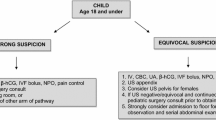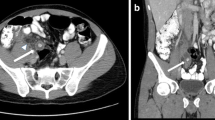Abstract
Objectives
Utilization of computed tomography (CT) scans in patients with presumed appendicitis was evaluated at a single institution to determine the sensitivity of this diagnostic test and its effect on clinical outcome.
Methods
Adult patients (age > 17 years) with appendicitis were identified from hospital records. Findings at surgery, including the incidence of perforation, were correlated with imaging results.
Results
During a 3-year period, 411 patients underwent appendectomy for presumed acute appendicitis at our institution. Of these patients, 256 (62%) underwent preoperative CT, and the remaining 155 (38%) patients did not have imaging before the surgery. The time interval between arrival in the emergency room to time in the operating room was longer for patients who had preoperative imaging (8.2 ± 0.3 h) compared to those who did not (5.1 ± 0.2 h, p < 0.001). Moreover, this possible delay in intervention was associated with a higher rate of appendiceal perforation in the CT group (17 versus 8%, p = 0.017).
Conclusions
Preoperative CT scanning in patients with presumed appendicitis should be used selectively as widespread utilization may adversely affect outcomes. The potential negative impact of CT imaging includes a delay in operative intervention and a potentially higher perforation rate.
Similar content being viewed by others
References
Antevil JL, Rivera L, Langenberg BJ, Hahm G, Favata MA, Brown CVR. Computed tomography-based clinical diagnostic pathway for acute appendicitis: Prospective validation. J Am Coll Surgeon 2006;203:849–856.
Bendeck SE, Nino-Murcia M, Berry GJ, Jeffery RB. Imaging for suspected appendicitis: negative appendectomy and perforation rates. Radiology 2002;225:131–136.
Old JA, Dusing RW, Yap W, Dirks J. Imaging for suspected appendicitis. Am Fam Phys 2005;71:71–78.
Bijnen, CL, van den Broek, WT, Bijnen, AB, de Ruiter, P, Gouma, DJ. Implications of removing a normal appendix. Dig Surg 2003;20:215–221.
Rao PM, Rhea JT, Novelline RA, Mostafavi AA, McCabe CJ. Effect of computed tomography of the appendix on treatment of patients and use of hospital resource. N Engl J Med 1998;338:141–146.
Horton MD, Counter SF, Florence MG, Hart MJ. A prospective trial of computed tomography and ultrasonography for diagnosing appendicitis in the atypical patients. Am J Surg 2000;179:379–381.
McGory ML, Zingmond DS, Nanayakkara D, Maggard MA, Ko CY. Negative appendectomy rate: influence of CT scans. Am Surgeon 2005;71:803–808.
Bickell NA, Aufses AH, Rojas M, Bodian C. How time affects the risk of rupture in appendicitis. J Am Coll Surgeon 2006;202:401–406.
Ditillo MF, Dziura JD, Rabinovici R. Is it safe to delay appendectomy in adults with acute appendicitis? Ann Surg 2006;244:656–660.
Lee, SL, Walsh, AJ, Ho, HS. Computed tomography and ultrasonography do not improve and may delay the diagnosis and treatment of acute appendicitis. Arch Surg 2001;136:556–562.
Hong, JJ, Cohn, SM, Ekeh, AP, Newman, M, Salama, M, Leblang, SD. A prospective randomized study of clinical assessment versus computed tomography for the diagnosis of acute appendicitis. Surg Infect 2004;5:223–224.
Fuchs JR, Schlamberg JS, Shortsleeve MJ, Schuler JG. Impact of abdominal CT imaging on the management of appendicitis: an update. J Surg Res 2002;106:131–136.
Menes TS, Aufses AH, Rojas M, Bickell NA. Increased use of computed tomography does not harm patients with acute appendicitis. Am Surgeon 2006;4:326–329.
Mittal VK, Goliath J, Sabir M, Patel R, Richards BF, Alkalay I, ReMine S, Edwards M. Advantages of focused helical computed tomographic scanning with rectal contrast only vs triple contrast in the diagnosis of clinically uncertain acute appendicitis. Arch Surg 2004;139:495–500.
Walker S, Haun W, Clark J, McMillin K, Zeren F, Gilland T. The value of limited computed tomography with rectal contrast in the diagnosis of acute appendicitis. Am J Surg 2000;180:450–455.
Torbati SS, Guss DA. Impact of helical computed tomography on the outcomes of emergency department patients with suspected appendicitis. Acad Emerg Med 2003;10:823–829.
Hershko DD, Sroka G, Bahouth H, Ghersin E, Mahajna A, Krausz MM. The role of selective computed tomography in the diagnosis and management of suspected acute appendicitis. Am Surgeon 2002;68:1003–1007.
in’t Hof KH, van Lankeren W, Krestin GP, Bonjer HJ, Lange JF, Becking WB, Kazemier G. Surgical validation of unenhanced helical computed tomography in acute appendicitis. Br J Surg 2004;91:1641–1645.
Fuchs, JR, Schlamberg, JS, Shortsleeve, MJ, Schuler, JG. Impact of abdominal CT imaging on the management of appendicitis: an update. J Surg Res 2002;106:131–136.
Author information
Authors and Affiliations
Corresponding author
Additional information
DISCUSSION
Attila Nakeeb, M.D. (Indianapolis, IN): Thanks for a very elegant presentation and for the opportunity to review your manuscript. I think it has become clear that in many hospitals in the United States nobody goes to the operating room for an appendectomy without a CAT scan. Your study shows that a CT scan doesn't really help and it may actually be detrimental to your patients. A high index of suspicion and a good clinical exam seem to be more important in treating patients in a timely fashion and hopefully preventing perforations.
Understanding the limitations of a retrospective study, do you have any information on how many patients had CT scans in your institution to rule out appendicitis? What is your overall denominator in these patients and how many of those patients were never seen by a surgeon? Also, you have clearly shown in your study that the sensitivity is about 90%, the specificity is less than 70%, and your negative predictive value is less than 40% for CT scans in your hands. You did your scans with both oral and IV contrast. In the literature, using rectal contrast alone, you get about a 95% accuracy rate. Have you discussed changing your CT protocol to rectal contrast for patients who are specifically being evaluated to rule out appendicitis.
Finally in terms of the higher perforation rate in patients undergoing CT scans and the subsequent delay in getting to the OR, have you looked at your outcomes in those patients in regards to increases in complications, pelvic abscess, or increase in the length of stay?
I really enjoyed the paper. Thanks.
Sandeepa Musunuru, M.D. (Madison, WI): We do not have information regarding the number of patients evaluated with abdominal pain in the emergency room, or if these patients were seen by a surgical resident or attending. This is a weakness of our study due to its retrospective nature.
Regarding the second question regarding the use of rectal contrast, based on a prospective randomized study by Mittal et al., randomizing points to triple contrast vs. rectal only, there was no difference in the negative appendectomy rate.
As far as follow-up of patients for complications and length of stay, this was not included in this study.
David W. Butsch, M.D. (Barre, VT): I enjoyed your paper. I believe you said that you used the indeterminate group to be put into the negatives so that when you get your final results that might make your false negative rate higher. Did you have to take that group out and then give the rate of success of the ones that were read as positive?
Dr. Musunuru: The indeterminate scans were included in the negative scan category for statistical analysis since they did not enhance clinical decision making.
Jose M. Velasco, M.D. (Chicago, IL): I realize that it is a retrospective study. Thank you for bringing the paper and this issue to us. It is a source of frustration for all of us.
Do you have any idea as to who made the decision to obtain a CT scan? Was it before a clinical evaluation or afterwards? We are trying to encourage our residents to see the patients before a CT scan is done. Two, there are some issues as to whether a patient with a perforated appendix should be operated upon or should be treated non-operatively. Did you look at the CT scans on those patients that had perforation? Were you able to correlate whether the CT scan really was ordered because of a high suspicion for perforation and then it would be indicated? And I wouldn't include those patients. And the specificity in your study is really very low, and when you look at the series that have been published, it is much higher. Any idea why? Is it maybe technique?
Thank you. I really enjoyed it.
Dr. Musunuru: The first question was who ordered the CT scan. We do not have specific numbers of who ordered the CT scan. However at our institution, a majority of patients with acute appendicitis present to the emergency room and therefore, an emergeny medicine physician will evaluate and order the CT scan. However, if a surgical consult is requested prior to obtaining a CT scan, a surgical resident will conduct a history and physical exam and determine if imaging is necessary.
Dr. Velasco: If the person evaluated the patient clinically, did he have any idea of how frequently did the CT scan change the clinical evaluation? In other words, what is the impact of a CT scan on a patient that has clinically been evaluated?
Dr. Musunuru: The CT scan should be a tool that enhances decision making, especially in cases of atypical presentation and women of childbearing age, because of the larger differential diagnosis. Unfortunately we did not evaluate how often CT scans changed decision making. We specifically looked at patients that were operated on for presumed appendicitis, not patients with abdominal pain who were being evaluated. These are two very different patient populations, and different questions are being asked.
Dr. Velasco: The final question was, were you able to identify those patients that had a perforation and did you review the CT scan findings and how good was the CT scan in identifying those patients that had a perforation?
Dr. Musunuru: Perforations were identified based on pathology and visualization in the operating room since a majority of perforations were micro perforations not identified on CT imaging.
Rights and permissions
About this article
Cite this article
Musunuru, S., Chen, H., Rikkers, L.F. et al. Computed Tomography in the Diagnosis of Acute Appendicitis: Definitive or Detrimental?. J Gastrointest Surg 11, 1417–1422 (2007). https://doi.org/10.1007/s11605-007-0268-y
Received:
Accepted:
Published:
Issue Date:
DOI: https://doi.org/10.1007/s11605-007-0268-y




